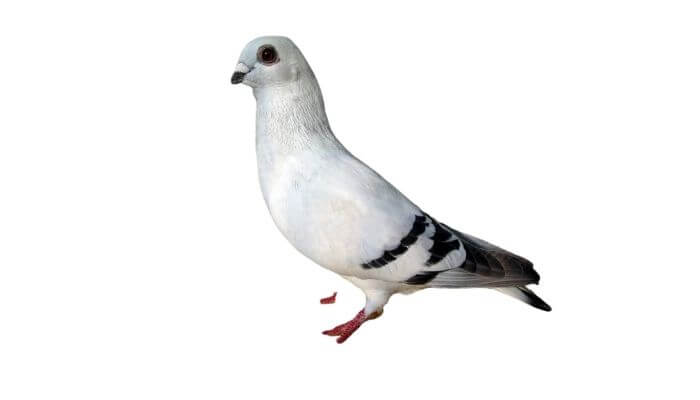The Damascene pigeon, also known across the world as the Istanbullu and generally in the USA as the Mahomet is one of the oldest pigeon breeds. It is particularly known for its flight ability and large, dark eyes.
Origins of the Damascene Pigeon
As the name suggests, the Damascene pigeon is believed to have originated in the region surrounding Damascus in Syria. Damascene, obviously, comes from the word Damascus although some schools of thought place its origins in Turkey or Persia (Iran).
The breed is thought to be as much as 3000 years old, having been mentioned in Egyptian stone carvings and papyrus scrolls.
It was referred to as Mahomet in the work, The Ornithology of Francis Willughby of Middleton in the county of Warwick Esq in 1667, where he compared the bird’s eyes to the large dark eyes of people of the Middle Eastern countries.
In another work – A Treatise of Domestic Pigeons – by John Moore in 1765, a different version of the etymology of the pigeon’s name is theorized.
He believed the tale that this pigeon in the form of the Holy Spirt (a common form of pigeon symbolism) spoke into the ear of Muhammed, the Founder of Islam, hence the name Mahomet.
The name Mahomet was mostly displaced when the bird was imported into Europe. The first examples were imported from Constantinople (Istanbul) by James Wallace of Glasgow in 1868. When he first exhibited them in 1879, he called them Damascene.
The birds were originally considered a flying bird with the Turks using them for flight displays as lats as 1954. Today though, they are mostly kept as an exhibition breed.
Distribution And Habitat of the Damascene Pigeon
Although imported into Europe from all over the Middle East (including as far as Afghanistan) until 1914, the bird do not do well in the War Years, and they had died out in Europe by the end of World War II.
They were however reintroduced and now thrive in the Middle East and Europe, although in North America they are still considered to be quite a rare breed.
The Damascene is domesticated and therefore its habitat is domestic, being kept in cages and lofts by their owners. They are suitable for most climates.
Damascene Pigeon Appearance
The Damascene pigeon is a medium-sized breed weighing around 370-450 grams (13-16 oz).
It has a bold, vigorous-looking carriage and is famed for its postural beauty.
The Damascene’s most striking trait is its large, bright eyes that are surrounded by dark plum-colored ceres.

They have a fairly large, rounded head and a blunt, stocky beak that is dark in color.
It is an entirely icy-white blue or silver-grey bird that boasts black wing bars and tail tip.
The under feathers of the Damascene pigeon’s neck are usually dark grey, which matches the color of the bird’s skin. The primary flight feathers of the Damascene pigeon grow darker as they move towards the tops.
In the ideal standard for the breed, there should be no markings on the head or the breast of the Damascene pigeon.
Damascene pigeons can also be grouse legged with a shooter layer of feathers that cover the limbs. However, clean, short legs with bright red feet and black toenails are generally preferred by most breeders.
The Character of a Damascene Pigeon
Damascene pigeons are notoriously very strong and hardy pigeons, but they aren’t just all brawn and no brains! They are also incredibly intelligent and benefit hugely from being given space to fly.
Damascene Pigeon Diet
You won’t be surprised to learn that the diet for a Damascene pigeon is very much akin to the general granivorous diet of most other pigeon breeds, namely
- Seeds
- Grains
- Berries
- Vegetables
- Fruits
- Nuts
They also need a supply of grit for digestion and a supply of fresh, clean water to drink.
Mating And Breeding Damascene Pigeons
The nature of being a fancy pigeon means that the vast majority of mating and breeding of Damascene pigeons is done in a controlled and selective manner by the owners.
Breeders will select birds that have the most ideal characteristics for their species in an attempt to continue the line in as pure and ‘optimum’ way as possible.
Damascenes have no difficulty finding a mate and when they start to coo and strut, an audience is always attracted.
Damascene pigeons are noted for being very good parents, tending to look after their young for a longer period on average compared to other breeds of domestic pigeon.
Taking Care of Damascene Pigeons
Looking after the Damascene pigeon is a case of following general pigeon care.
Even though an exhibition bird, one of the beauties of this breed is its graceful flight so as an owner you can make the most of this.
Build a loft with landing boards and allow them to fly so you can see them dart and dive and slice through the air in an agile energetic display. They have good homing instincts and will come home to the loft.
If you don’t have the space or ability to allow your pigeons access to the true outdoors, then perhaps the Damascene pigeon isn’t the best choice for your collection.
